Training by Lampstanding
Teacher Training throughout the Sunday School year
Print the PDF to get both the Teacher Be-attitudes and Lampstanding articles.
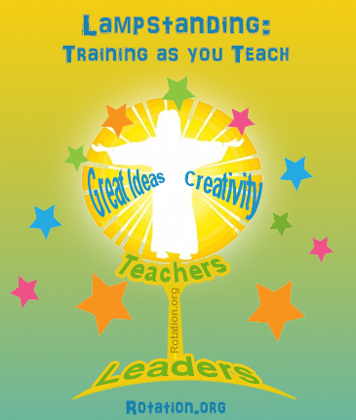
Training should not just be an event.
Events are great, and we even have a great teacher training event described here. But what about the rest of the year? For better or worse, most training is "on the job" --and that type of training can be great IF you have someone helping you, showing you what to do, holding you accountable for the results, and cheering you on.
This "Paste in My Hair" Teacher Training Blog post describes a way to do just that --how to improve and expand teaching skills as they teach throughout the year --by raising up great ideas and great expectations.
We call it "Training by Lampstanding."
Lampstanding in brief:
Lampstanding values the talent you already have and creative opportunities in upcoming lesson plans and seeks to support it and share it with other teachers.
1. In Lampstanding, the leader raises up the teacher's awareness of a key creative opportunity coming up in a lesson plan. The leaders says, "Hey, I see that you have a really neat Bible study activity coming up in two weeks, Let me help you get prepared for it, then afterward, let's share what you did with our other teachers."
The leaders raises up the expectation that certain upcoming lesson activities and techniques are important, and the leader raises up their level of support to help the teacher make it happen.
2. Lampstanding is raising up a teacher's gifts to not only shine on other students, but shine as an example to other teachers. (See ways to lampstand to other teacher below!)
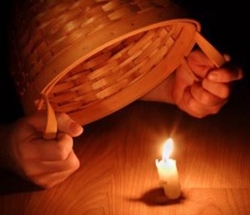
The Problem of "BUSHEL-SMOOSHING"
The problem that lampstanding seeks to address (other than the need for on-going training) is that a lot of "bushel smooshing" has been going on in Sunday School. In fact, "Bushel-Smooshing" is the opposite of Lampstanding.
Examples of "Bushel-Smooshing"
- Leaders who hand out lesson plans to teachers and don't follow up on what the teacher may need help with or debrief how the lesson went.
- Teachers who take the "path of least resistence and simplest preparation" --avoiding creative ideas they are unfamiliar with or require extra effort.
- Video, music, and drama resources going unused.
- Worksheet and arts & craft activities being over-used.
- A teacher who "stays in their lane" subjecting students all year long to the teacher's learning preferences and blindspots.
- Teachers who think they don't have the time to be creative or try something new.
Bushel-Smooshing eventually leads to teacher and student depletion and darkness. Whereas, lampstanding offers a friendly, supportive (and biblical!) approach to help teachers succeed at being more creative and successful in their lessons, and share their inspiring light with other teachers.
Let's get into a few more "how to" details.
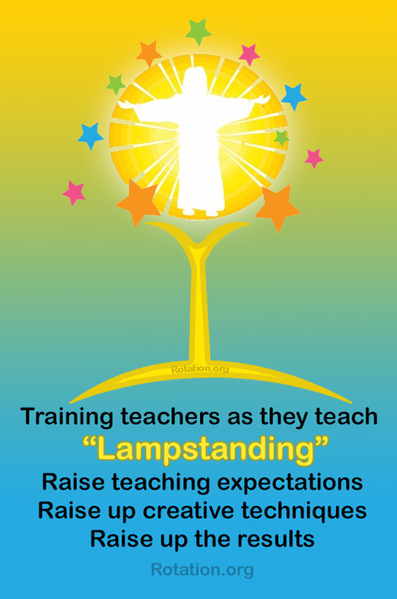
Lampstanding is...
- Setting creative expectations higher, instead of hiding them politely under a bushel.
- Raising up awareness of the creative techniques in upcoming lessons to make sure the teacher sees them for what they are trying to accomplish, instead of how much work they will be.
- Providing resources to help teachers, lessons, and techniques shine. This includes being there to help prep and assist the day of the lesson you have identified.
- Following up afterward with teachers about what they learned and would change.
- Sharing the results with others.
Lampstanding is also leading by example... identifying new things that will stretch your skill-set and theirs, and after doing them, sharing the light.
Leaders: Lampstanding is not heavy-handed; it is about caring leadership, and sharing leadership. ⇒It's sharing what you think is exciting in an upcoming lesson plan and offering your hands-on support. It's about expecting and equipping teachers to flourish, and raising up the results to inspire others.
Teachers: "Lampstanding" is about building on your gifts, getting the support you need, and realizing your insights can be a blessing to others --all in an effort to evangelize our kids.
Ways to Lampstand to Other Teachers
Have the teacher describe their creative approach and the kids' reaction to it in an upcoming email to teachers and parents.
Use your cellphone to create a short 1-minute video of the teacher describing what they did and how it was received. (Leader: Show up with your cellphone during class to record 20 seconds of the what the kids are doing, then interview the teacher when the class is over.)
Plan a "Lampstand Sharing" Event -- in which each teacher is given several minutes to describe to the other teachers some of the creative lesson activities they've been using. Work with teachers ahead of time to identify certain activities/techniques that you'd like to see them "present" at the next teacher training get-together.

A Strategy for Getting Started with Lampstanding
1) Raise expectations among the teachers. Let them know through training events, communications, one-on-one, and your presence alongside them in the classroom, that you want them to embrace creative approaches rather than avoid them, and that you will be there to support them.
2) Find a teacher who wants to be the first to be lamp-standed. Work with him or her to identify, plan, and lead upcoming creative opportunities in their lesson plans. Then LAMPSTAND the DAYLIGHTS out of that upcoming lesson and the results so that others can see and be drawn to its light. LAMPSTAND the teacher's insights and successes to others via conversations, email, handouts, and discussion at your next get-together. Be there with your cellphone camera to "catch them in the act of being awesome" and share that with your congregation.
Getting resistance? Your less creative teachers may not appreciate being "put on the spot." Thus, even your attempts to "lampstand" may tell you about the condition of the teaching. Start off with teachers who are not afraid to share. Then go to your more-resistant teachers with support in helping them first DO the activity in class, and share it for the first time with others in a non-threatening way (such as via a short story via an email).
Seems so simple, right? (LOL)
Well, it is if you do it, and there’s nothing like putting names and dates on a calendar to get something done.
- Find a willing teacher.
- Pull out your calendars and lesson plans
- Make a plan to do some Lampstanding together.
Finding Lesson Plans and Activities Worthy of Lampstanding
Some curriculum out there simply does not challenge your teachers, let alone your kids. It's "read and talk about this, and color or paste that." In a word: Yuck.
But the better curriculums do have some variety, and a sharp leader or teacher will be able to spot the opportunities in them for lampstanding.
If you're looking for some REALLY CREATIVE lesson plans to stretch your teacher with, then look no further than our own Writing Team Lesson Sets. Whether you're a traditional program or Rotation Model Sunday School, the Team's "extra creative" lesson sets offer you many different approaches to the same story: Art, Drama, Games, Videos, Music, "Science," Software, Cooking, and Movement.
You can also read the Workshop Manuals and workshop forum resources we've written for various workshops. These are full of techniques. Read the Creative Bible Reading and Discussion thread. Read the lesson plans people are sharing to see how they are creatively teaching.
The following is not a commercial, it’s the truth. During our 2015-2018 WT renovation of the Rotation Writing Team lesson sets, we purposefully emphasized including a VARIETY of ways to read the Bible, discuss questions, do interactive reflections, pray, etc. To cherry-pick this variety of techniques, you only have to look ACROSS the lessons in a set and across multiple sets. Or, simply teach with the lessons in the set, and over time teachers will learn a multitude of techniques. We also added "teaching tips" in a bunch of the lessons to explain to the teacher the "why" of doing something a certain way.
Lampstanding was written by Rotation.org's resident "Paste in My Hair" bloggers and Christian educators Neil MacQueen and Heidi Weber, with contributions from Amy Crane.
Print the PDF of both this article and the Teacher Be-attitudes Training Event.

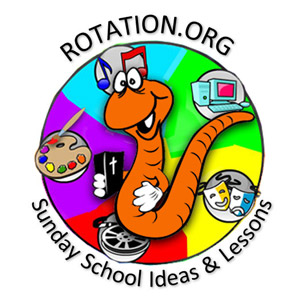



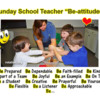

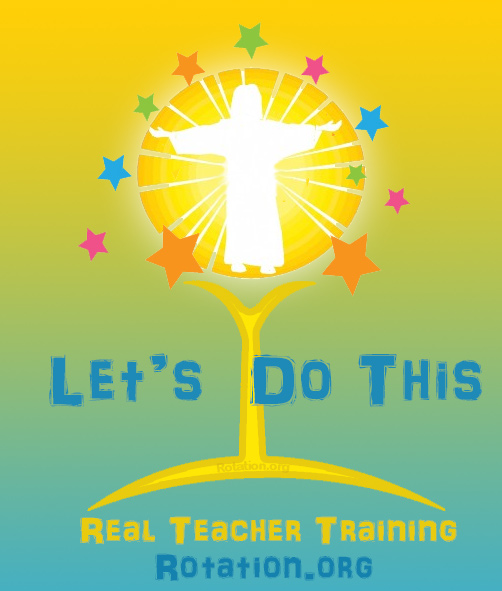






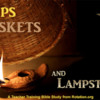
 Many of the "Paste in My Hair" teacher handouts can be used as training exercises and discussion starters in your training events.
Many of the "Paste in My Hair" teacher handouts can be used as training exercises and discussion starters in your training events. This can also be an opening discussion starter at a training event about why we teach. Which reasons from this list mean the most to you?
This can also be an opening discussion starter at a training event about why we teach. Which reasons from this list mean the most to you?


 The free video is an attention-grabbing two-and-a-half-minute discussion starter. It includes lots of heart-pounding leaps of faith and scripture.
The free video is an attention-grabbing two-and-a-half-minute discussion starter. It includes lots of heart-pounding leaps of faith and scripture.


